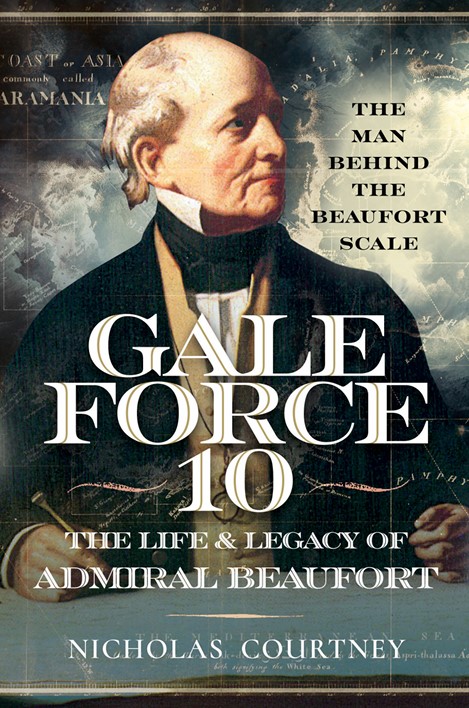From seafarer to force of nature
Gale Force 10, by Nicholas Courtney
 The 19th century must surely be the era when one person could have the biggest influence on history. It was a time when fortunes were made and lost, famous battles were fought, whole continents were explored for the first time, new industries sprang up almost overnight, and new scientific discoveries changed the way in which we viewed and travelled the world – and often, the same people were involved in all of them.
The 19th century must surely be the era when one person could have the biggest influence on history. It was a time when fortunes were made and lost, famous battles were fought, whole continents were explored for the first time, new industries sprang up almost overnight, and new scientific discoveries changed the way in which we viewed and travelled the world – and often, the same people were involved in all of them.
One such pioneer and savant was Rear-Admiral Sir Francis Beaufort (1774–1857). Born in Ireland to a family of Huguenot descent, he first went to sea in 1789 onboard the ill-fated British East India Company vessel Vansittart.
Undeterred by his experience of shipwreck, he joined up as a midshipman in the Royal Navy and rose to the rank of captain during battles with the French.
While serving, he kicked off his career as a hydrographer and cartographer by taking depth soundings and bearings, making astronomical observations and measuring shorelines to create new charts.
He also created his most famous legacy, the Wind Force Scale, which is familiar not only to seafarers, but to anyone who has ever tuned into the Shipping Forecast.
In 1829, he was elected as a Fellow of the Royal Astronomical Society and appointed as the British Admiralty Hydrographer of the Navy (despite being self-taught). During his long tenure, the production of new charts increased from 19 in 1830 to 1,230 per year and they became a truly global resource.
His work there also meant that he directed maritime explorations and experiments that are still famous today – such as Darwin's voyage on HMS Beagle and the Antarctic voyage of 1839–1843 by James Clark Ross. He even took the time to help found the Royal Geographical Society. In a less savoury episode, he also had an incestuous relationship with his sister after the death of his first wife, something which caused him extreme anguish and was revealed only in journals that he wrote in his own personal cipher.
Nicholas Courtney's detailed book brings the story of this truly remarkable man to life, with very extensive quotes from the contemporary sources. It admirably covers the broad range of Beaufort's achievements, from the warlike to the technical.
Gale Force 10: The Life and Legacy of Admiral Beaufort
By Nicholas Courtney
Pen & Sword, £16.99
ISBN: 978 10361 35058
Buy this book in the Nautilus Bookshop
While you're there, why not browse the rest of the titles in our unique maritime bookshop, which sells all the books reviewed on these pages.
Buy nowMore Books
The precarious path from piracy to prosperity
The Resurrected Pirate, by Craig S ChapmanThe Resurrected Pirate is a remarkable story told in an engaging way, illustrating for the modern reader the desperately narrow passage between life and death that a seafarer in this period might have to navigate.
Carving out a career
Ships' Figureheads: Famous Carving FamiliesThe decoration of ships with figureheads was a way to present the might of military and mercantile power for centuries. These days, the skills needed to make these sculptures are kept alive by experts such as Andrew Peters, who has worked on restoration projects such as the Cutty Sark tea clipper.
Knotty problems solved
The Knot Bible: The Complete Guide to Knots And Their Uses by Nic ComptonKnot-tying is a vital competency skill for seafarers, and this expanded edition of The Knot Bible by Nic Compton offers guidance on over 200 knots and their practical uses.
Why it's nice to splice
Splicing modern ropes, 2nd edition: a practical handbook by Jan-Willem PolmanSplicing rope is as an essential skill for seafarers as tying a knot, but some skills are disappearing. This definitive guide on why splicing gets more from your rope is a great stocking filler for all boaters, whether recreational or commercial.
